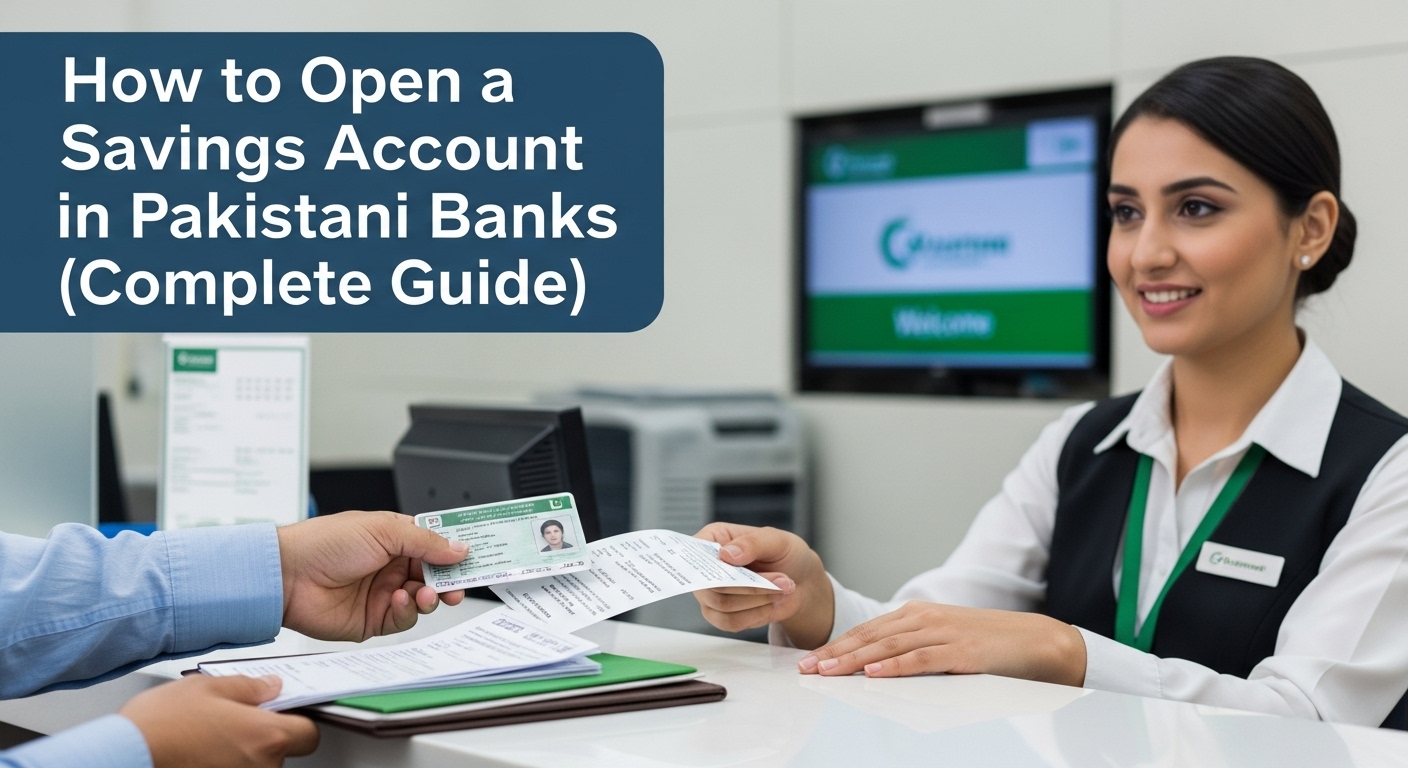Welcome to your comprehensive guide on opening a savings account in Pakistan! Whether you’re new to banking or looking to manage your finances more effectively, this guide is designed to walk you through every step. We’ll cover everything from choosing the right bank to understanding the different types of accounts, ensuring you have all the information you need to make an informed decision.
Opening a savings account is a crucial step towards financial security. It allows you to safely store your money, earn a profit on your deposits, and provides a convenient way to manage your daily transactions. In Pakistan, banks offer a variety of savings accounts tailored to different needs, from basic accounts to those with higher profit rates or specialized features.
Understanding Why a Savings Account is Essential
A savings account is more than just a place to keep your money; it’s a tool for financial growth and stability. Here’s why having one is so important:
Safety and Security
When you keep your money at home, it’s vulnerable to theft, loss, or damage. Banks provide a secure environment, with advanced security systems and insurance coverage, ensuring your funds are protected. The State Bank of Pakistan (SBP) regulates all commercial banks, adding another layer of security and trust.
Earning Profit
Unlike keeping cash idle, a savings account allows your money to grow. Banks offer profit (or interest in conventional banking) on the balance you maintain in your account. This profit is typically calculated daily and credited monthly or semi-annually, helping your money increase over time without any effort on your part.
Budgeting and Financial Discipline
Having a separate savings account encourages you to set aside funds for future goals, like buying a home, educating your children, or even for unexpected emergencies. It helps you track your savings progress and builds financial discipline.
Convenient Access to Funds
While designed for saving, these accounts still offer easy access to your money through ATMs, debit cards, online banking, and mobile apps. This means you can deposit or withdraw funds whenever you need to, making it a flexible financial tool.
Facilitating Transactions
Many savings accounts come with a debit card, allowing you to make purchases, pay bills, and transfer funds electronically. This reduces your reliance on cash and simplifies your financial transactions.
Choosing the Right Bank in Pakistan
Pakistan has a robust banking sector with numerous conventional and Islamic banks. Selecting the right one depends on your individual needs and preferences. Here’s how to approach this decision:
Research Different Banks
Don’t just walk into the first bank you see. Take some time to research various banks operating in Pakistan. Look at their offerings, reputation, and customer service. Major banks like Habib Bank Limited (HBL), United Bank Limited (UBL), Meezan Bank, Bank Alfalah, Allied Bank, and National Bank of Pakistan (NBP) are widely accessible, but smaller, regional banks might offer competitive benefits for specific needs.
Compare Profit Rates
One of the main reasons to open a savings account is to earn profit. Banks announce their profit rates, which can vary significantly. Check the latest profit rates offered by different banks. Keep in mind that these rates are subject to change based on the State Bank of Pakistan’s monetary policy.
Consider Minimum Balance Requirements
Some savings accounts require you to maintain a minimum monthly or quarterly balance to avoid service charges. If you’re an absolute beginner or don’t plan to keep a large sum in your account, look for banks that offer “Asaan Accounts” or similar products with no minimum balance requirements or very low ones.
Evaluate Service Charges
Banks charge various fees for services like cheque books, debit card issuance and annual fees, inter-bank fund transfers, and ATM withdrawals from other bank ATMs. Always review the “Schedule of Charges” (SOC) for any account you’re considering. This document is usually available on the bank’s website or at any branch.
Look at Branch and ATM Network
While digital banking is on the rise, having access to a nearby branch or ATM can be very convenient, especially for cash deposits or withdrawals, or when you need face-to-face assistance. Consider the bank’s network in your area.
Assess Digital Banking Services
Most banks in Pakistan offer internet banking and mobile banking apps. These services allow you to manage your account, pay bills, transfer funds, and check your balance from the comfort of your home. Compare the features and user-friendliness of different banks’ digital platforms.
Islamic vs. Conventional Banking
Pakistan has a strong Islamic banking presence. Islamic savings accounts operate on Shariah-compliant principles, such as Mudarabah, where the bank acts as a manager of your funds and shares the profit (or loss) generated from Shariah-approved investments. Conventional savings accounts, on the other hand, typically offer interest. Choose the option that aligns with your beliefs and financial preferences.
Types of Savings Accounts Available in Pakistan
Pakistani banks offer a range of savings accounts to cater to diverse customer needs. Understanding these can help you pick the best fit:
Regular Savings Account (PLS Savings Account)
This is the most common type of savings account. PLS stands for Profit and Loss Sharing, meaning the profit you earn is based on the bank’s overall profitability (for Islamic banks) or a pre-determined interest rate (for conventional banks). These accounts usually have a moderate minimum balance requirement and offer basic banking services.
Asaan Savings Account
Introduced by the State Bank of Pakistan, these accounts are designed to promote financial inclusion, especially for individuals with limited income proof. They typically have a very low or no minimum balance requirement and simplified account opening procedures. However, they might have limits on monthly credit and debit transactions.
Kids/Teens Savings Accounts
Many banks offer specialized accounts for minors, encouraging saving habits from a young age. These accounts are usually operated by a parent or guardian until the child reaches a certain age. They might come with educational benefits or specific saving goals.
Senior Citizen Savings Accounts
Tailored for senior citizens, these accounts often offer higher profit rates or special privileges, recognizing their need for a stable income stream during retirement.
Women’s Savings Accounts
Some banks have introduced savings accounts specifically for women, often featuring benefits like lower minimum balance requirements, free insurance, or discounts on certain services, aimed at empowering women financially.
Foreign Currency Savings Accounts
If you receive remittances from abroad or deal in foreign currencies, you can open a foreign currency savings account (e.g., USD, GBP, EUR). These accounts allow you to save in foreign currencies and often offer specific profit rates for those currencies.
Roshan Digital Account (RDA)
Specifically designed for Non-Resident Pakistanis (NRPs) and resident Pakistanis with declared assets abroad, RDA allows overseas Pakistanis to open and operate accounts digitally without visiting a branch. It offers both current and savings options, allowing easy remittances, investments in Pakistan, and bill payments.
Step-by-Step Guide to Opening a Savings Account
Once you’ve chosen a bank and a specific type of savings account, the process of opening it is generally straightforward. Here’s a detailed breakdown:
Step 1: Gather Your Required Documents
- For Individuals (Resident Pakistani):
- Original and Photocopy of your Valid Computerized National Identity Card (CNIC) or Smart National Identity Card (SNIC). If your CNIC doesn’t have a photo, you might need additional attested copies of a driving license, service card, or educational degree.
- Proof of Profession/Source of Income: This is a key requirement to comply with Anti-Money Laundering (AML) regulations.
- For Salaried Individuals: Latest salary slip (not older than 3 months) or an employment certificate from your employer.
- For Business Owners/Self-Employed: Business letterhead with an account opening request, NTN certificate (if applicable), sales tax registration (if applicable), or any document proving business existence and income.
- For Freelancers: Agreements or email/letter-based correspondence with clients, or bank statements showing regular income from freelance work.
- For Pensioners: Pension book or proof of pension.
- For Housewife: Valid proof of source of income of husband/parents/beneficial owner along with a self-declaration form.
- For Students: May require an undertaking from parents/guardians and their source of income documents.
- Two Recent Passport-Sized Photographs: Some banks may require these.
- Proof of Address: A recent utility bill (electricity, gas, telephone) or a tenancy agreement in your name, if your CNIC address is different from your current residential address.
- Initial Deposit: While some accounts (like Asaan Accounts) have no minimum initial deposit, others might require a small amount (e.g., PKR 100 or PKR 500) to activate the account.
- For Minors:
- Original and photocopy of the minor’s Form B or Birth Certificate.
- Original and photocopy of the guardian’s valid CNIC/NICOP.
- Documentary evidence of the guardian’s source of income.
Common Mistakes/Challenges & Tips:
- Expired CNIC: Always ensure your CNIC is valid. Banks will not accept an expired one.
- No Proof of Income: This is a common hurdle. If you don’t have formal documents, ask the bank about “Asaan Accounts” which have relaxed income proof requirements. For freelancers, clear communication with the bank about your income source is crucial.
- Photocopy Clarity: Make sure your photocopies are clear and legible.
Step 2: Visit Your Chosen Bank Branch
- Walk into the bank and approach the customer service desk or the new accounts counter.
- Inform them that you wish to open a savings account.
Tips:
- Call Ahead: Some banks allow you to book an appointment or check the required documents over the phone, which can save you a trip.
- Comfortable Attire: Dress appropriately for a formal setting.
Step 3: Fill Out the Account Opening Form (AOF)
The bank representative will provide you with an Account Opening Form. This form requires detailed personal, financial, and contact information.
- The form will ask for your personal details (name, father’s/husband’s name, date of birth, CNIC number, residential address, contact number, email address).
- You’ll need to specify your profession and source of income.
- You might be asked for details about your expected monthly transactions.
- You’ll need to nominate a nominee (Next of Kin) who can claim your funds in case of unforeseen circumstances. Provide their full name, CNIC, and relationship to you.
- If you want a cheque book, debit card, or internet/mobile banking facilities, tick the relevant boxes.
- Read the terms and conditions carefully before signing. Don’t hesitate to ask the bank representative to explain anything you don’t understand.
Common Mistakes/Challenges & Tips:
- Incomplete Information: Ensure no fields are left blank. If a field doesn’t apply to you, write “N/A” (Not Applicable).
- Incorrect Details: Double-check all spellings, numbers, and addresses to avoid future complications.
- Not Understanding Terms: Many people skip reading the fine print. Take your time to understand the account features, charges, and conditions.
Step 4: Biometric Verification
After filling out the form, you will undergo biometric verification using your CNIC. This is a mandatory step as per State Bank of Pakistan regulations.
- The bank representative will guide you to a biometric machine connected to NADRA’s database.
- You will typically need to provide impressions of both your thumbs.
Common Mistakes/Challenges & Tips:
- Unclear Fingerprints: Ensure your fingers are clean and dry. If there’s an issue with your fingerprints, the bank might ask for an attestation from a gazetted officer or a senior bank official.
- NADRA Database Issues: Occasionally, there might be temporary issues with NADRA’s system. Be patient or try again later if instructed.
Step 5: Submit Documents and Initial Deposit
Once the form is complete and biometric verification is done, submit all your documents along with the initial deposit (if required).
- The bank representative will verify the documents against your originals and return the originals to you.
- They will provide you with a deposit slip for your initial deposit. Fill it out and deposit the money at the cash counter.
- You will receive a stamped acknowledgment or a provisional account number.
Tips:
- Keep a Record: Always keep a copy of your submitted application form and any deposit slips for your records.
- Ask for an Estimate: Ask the representative how long it will take for your account to become active and when you can expect your debit card and cheque book.
Step 6: Account Activation and Receiving Your Tools
After successful processing, your account will be activated, and you’ll receive your banking tools.
- Typically, your account is activated within a few business days. Some banks might activate it instantly for Asaan Accounts.
- Your debit card is usually issued within 7-10 working days and can be collected from the branch or sent to your registered address via courier. You’ll need to activate it by calling the bank’s helpline or using an ATM.
- Your cheque book will also be issued similarly.
- For internet and mobile banking, you’ll receive login credentials or instructions on how to set them up.
Common Mistakes/Challenges & Tips:
- Not Activating Debit Card: Remember to activate your debit card as soon as you receive it, otherwise, you won’t be able to use it for transactions or ATM withdrawals.
- Ignoring PIN Security: Never share your debit card PIN with anyone, not even bank staff. Memorize it and destroy any written records.
Important Considerations and Tips for Savings Account Holders
Once your savings account is open, there are a few things to keep in mind to manage it effectively and securely.
Understanding Profit Calculation and Payout
Profit on savings accounts is usually calculated on your daily average balance and paid monthly or semi-annually. The higher your average daily balance, the more profit you earn. Keep an eye on the bank’s profit rate announcements, as they can change.
Zakat and Withholding Tax (WHT)
In Pakistan, Zakat (a religious levy) is deducted directly from savings accounts at a specific rate (currently 2.5% of the balance) on the 1st of Ramazan each year, provided your balance meets the Nisab (minimum threshold). You can apply for a Zakat exemption by submitting a Zakat Declaration Form (CZ-50) to your bank if you qualify (e.g., being a non-Muslim or having assets below Nisab). Withholding Tax (WHT) is also applied on the profit earned on your savings, typically at different rates for filers (individuals who file their tax returns) and non-filers. Ensure your NTN (National Tax Number) is updated with the bank if you are a filer to avail of the lower tax rate.
Managing Minimum Balance
If your account has a minimum balance requirement, ensure you maintain it to avoid service charges. These charges can eat into your savings.
Regularly Reviewing Account Statements
Periodically check your account statements (physical or e-statements) to monitor your transactions, verify deposits and withdrawals, and ensure there are no unauthorized activities. Report any discrepancies immediately to your bank.
Safeguarding Your Account Details
Be extremely cautious with your account number, debit card number, PIN, and online banking passwords. Never share them with anyone over the phone, email, or suspicious websites. Banks will never ask for your full PIN or password via email or phone.
Using Digital Banking
Embrace internet and mobile banking. They offer immense convenience for checking balances, paying bills, transferring funds, and much more, reducing your need to visit a branch.
Dealing with Inactive/Dormant Accounts
If you don’t use your account for a certain period (usually 6 months to 1 year for inactive, and 1 year onwards for dormant), it may become inactive or dormant. To reactivate it, you typically need to visit the branch, provide a written request, and undergo biometric verification. Keep your account active by performing at least one transaction (deposit, withdrawal, bill payment) regularly.
Contacting Customer Service
If you have any queries, issues, or detect suspicious activity, contact your bank’s customer service immediately. Most banks have a dedicated helpline and often provide email support.
Conclusion
Opening a savings account in Pakistan is a straightforward process once you understand the requirements and steps involved. It’s a vital move towards securing your financial future, allowing your money to grow while providing convenient access. By choosing the right bank, understanding the different account types, and carefully completing the necessary documentation, you can embark on your savings journey with confidence.
Remember, patience and attention to detail are key. Don’t hesitate to ask bank representatives for clarification on any point. Your financial well-being is paramount, and a well-managed savings account is a cornerstone of that security. Happy saving!
Resources
- State Bank of Pakistan (SBP) website for regulations and consumer protection information.
- Official websites of commercial banks in Pakistan (e.g., HBL, UBL, Meezan Bank, Bank Alfalah, Allied Bank, NBP) for specific account details and Schedules of Charges.
- NADRA (National Database and Registration Authority) for CNIC-related information.




